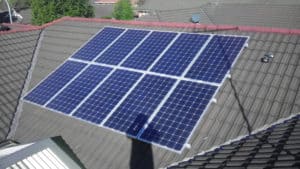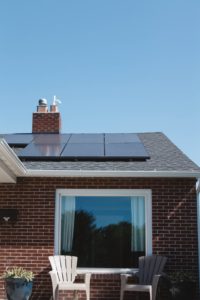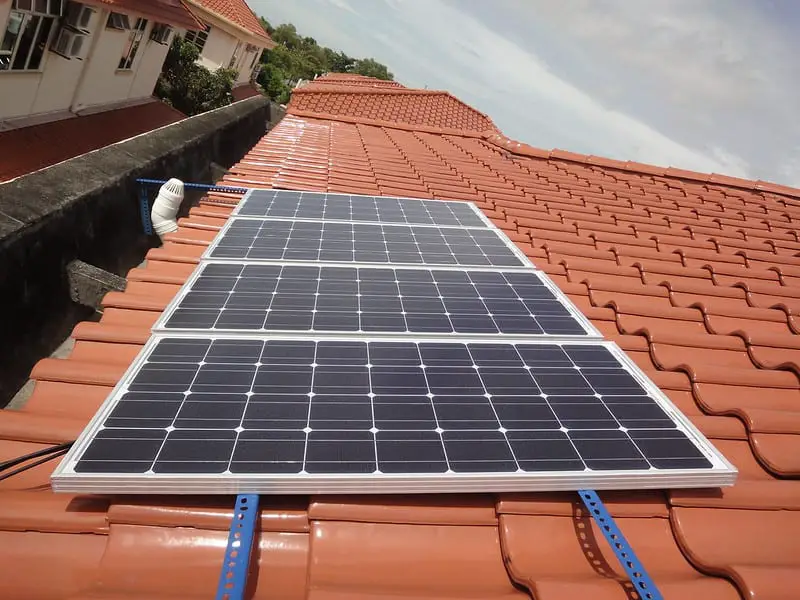
Let’s start with some not-so-good news: most of the manufactured homes out there, whether old or new generation, don’t have the correct roof structure and joint strength necessary for supporting the massive weight of PV (photovoltaic) solar panels. Also, many housing codes don’t permit solar panels on structures without a permanent foundation.
But that’s just bad news. There are numerous reasons why you would compromise or make adjustments on your roof just to add some solar modules.
- Mobile homes are known to use about twice the energy used in site-built homes for cooling and heating. For that reason, renewable energy comes out as the most affordable option on the table.
- Many local authorities tend to relax their rules regarding solar panel installation for this reason.
But I Still Want to Buy Manufactured Home Solar Panels….
If you have ascertained that your roof has all it takes to support your desired number of solar panels, and the local codes are all for it, you can embark on shopping for a kit.
There are a few things you need to consider if you want to choose the best solar modules:
- Type of The Solar Module
- Cost vs. Budget
- Efficiency
- Solar Panel Components
- Grid vs. Off-grid Solar Panels
- Weight
- Wattage
- Special features and Technologies
1. Type of The Solar Module – Monocrystalline vs. Polycrystalline vs. Amorphous
All solar modules in the market are not the same.
The type of cells in a module determines its type. You need to choose the type of cells that serves your needs.
These cells can be
- monocrystalline
- polycrystalline or
- amorphous.
Monocrystalline panels
Monocrystalline cells are made from the purest silicon the manufacturer could get.
For this reason, panels made from these cells tend to excel at generating electricity and boast the highest efficiency ratings you could find in any panel on the market.
Polycrystalline panels
On the part of the manufacturer, polycrystalline panels are faster to produce compared to any other type of panel.
- This makes them a bit cheap to acquire compared to, say, monocrystalline options.
- Also, they are highly efficient although not as high as monocrystalline options.
- While this type of panels may be affordable, they lag behind monocrystalline panels when it comes to the amount of power generated in a given period.
- Also, they tend to be large and less durable compared to monocrystalline options.
- If you live in a location prone to high temperatures or low-light situations, it would be in your best interest not to choose this type of panel.
Amorphous Panels
These panels are a little unique from the above two types in that they are made from very thin layers of silicon allowing them to be flexible enough to be bent. Better yet, they are lightweight compared to the above two popular types of panels.
Another good thing is that they can function flawlessly under high temperatures and in low-light environments.
If you are looking for a solar module option that can absorb a wide range of the light spectrum, choose the amorphous type of panels.
So, which type is best for a manufactured home? It’s going to depend on an array of factors as well as your own needs.
- Do you want the most efficient panels? Choose monocrystalline.
- Are you shopping on a budget but still want something larger? Choose polycrystalline.
- Is your home located in a hot locality or you plan to use the panels in low-light environments? Take the amorphous options.
2. Cost vs. Budget
Once you have settled for the right type of panel, the second logical factor to consider is its cost and the amount of money you are willing to spend on it.
The average cost of a solar panel is somewhere between $100 and $150.
Of course, the price tag is going to be determined by the type of panel and whether it comes with a few add-ons.
This cost can be low owing to the small size of roofs found on most manufactured homes (meaning you won’t go for the largest options). And because installation companies tend to charge per watt, you are more likely to pay between $2.51 to $3.31 for every watt installed.
It is recommended that you prepare a budget that adequately covers the cost of acquisition as well as the cost of installing the solar module. There is always a maximum amount of money you are willing to spend on the modules and installation process.
If you have $10,000 in your hands, for example, your budget will forbid you from spending anything beyond that amount of money on solar panel modules. Basically, a budget prevents you from overspending or potentially opting for models you didn’t consider at the beginning.

3. Efficiency
The efficiency of solar panels is such a big deal. Here, efficiency refers to the amount of energy that can be generated from a given amount of sunlight.
Panels with high efficiency can generate more energy from limited sunlight. Inefficient options, on another, produces little electricity under limited sunlight.
In practical terms, any two solar modules of similar physical size, let’s say one panel has a 21 percent efficiency rating in certain conditions and the other comes with a 14 percent efficiency rating in the same conditions, then the 21 percent efficient module will produce 50 percent higher kilowatt-hours (kWh) of electrical power under those conditions as the 14 percent efficient option. Thus, a highly efficient panel helps you maximize your energy consumption and bill savings.
Of course, you want the most efficient modules you can lay your hands on, but this decision may be influenced by your location among other factors.
There is no point in spending a lot of money on the most efficient panels you could find if you live in an area with plenty of sunshine in most parts of the year. If your area is often cloudy, then high efficiency becomes a priority factor.
- Most solar panel modules come with an efficiency between 15 percent and 20 percent.
- Monocrystalline panels tend to be the most efficient type of panels and come with the efficiency that exceeds 20 percent.
- Polycrystalline panels are the second most efficient, with efficiency somewhere between 15 percent and 17 percent.
- Most of the photovoltaic panels you will find in the store comes with a maximum of 20 percent efficiency.
- The efficiency seldom gets past 23 percent in the most efficient panels.
A few factors affect the efficiency of the panel:
- The material of construction (polycrystalline silicon, monocrystalline, cadmium telluride, etc.)
- reflection (efficiency may drop if a lot of light is reflected away from the panel) and
- wiring and busing are determining factors.
Brands with the most efficient panels (Source: energysage):
| Brand | Min. Efficiency (%) | Max. Efficiency (%) | Average Efficiency (%) |
|---|---|---|---|
| LG Solar | 18.40 | 22.00 | 20.04 |
| CSUN | 19.88 | 21.17 | 20.53 |
| Axitec | 18.96 | 20.45 | 19.78 |
| Peimar | 19.05 | 19.05 | 19.50 |
| REC Group | 16.50 | 21.70 | 19.05 |
| Astronergy | 18.10 | 19.10 | 18.62 |
| Hyundai | 16.20 | 19.40 | 18.49 |
| Canadian Solar | 15.88 | 19.91 | 17.88 |
| Heliene | 15.60 | 19.30 | 17.31 |
| Kyocera | 14.75 | 16.11 | 15.42 |
4. Solar Panel Components
The reason why you need to consider solar panel components when shopping for panels is that some suppliers offer their panels complete with some of the core components while others will require you to buy them separately.
For a solar power system to be complete, it must have two important components –
- the inverter and
- the mounting rack.
Inverters
Solar panels convert sunlight into a direct current (DC).
But since most household appliances and electronics use alternating current (AC), you need to use an inverter to convert the direct current and alternating current.
Solar panels use one of two types of inverters –
- the microinverter and
- the string inverter.
Microinverters are often found on the backside of the panel, produce more energy, but are expensive.
String inverters are often installed on walls away from the panel and are cheap compared to microinverters.
Mounting racks
Solar modules can’t be installed on a bare roof. Mounting racks helps the homeowner to secure the panels tightly on the roof to prevent.
You should choose mounting racks that can be easily adjusted for angle and height.
Most solar panel kits come with one of these inverters and some or all of other essential accessories such as charge controllers, batteries, and cables.
Finding a kit that includes most of these items reduces the amount of money you need to spend on your solar module installation project.
5. Grid vs. Off-grid Solar Panels
How do you intend to use the solar panels in your mobile home?
There are always two motivations –
- you probably want to supplement your current power supply with solar power or
- you want to remove some power-thirsty appliances from your home’s main power supply line.
Either way, you will need to choose between two classes of panels –
- grid-tied solar systems and
- off-grid solar panels.
Grid-tied systems tend to be expensive compared to Off-grid systems. They also require a bigger size of the roof than the latter class.
Note that Grid-tied and Off-grid systems are specially designed for the job, meaning you can’t use usual panels for any of these installations.
Grid-tied solar systems
This is a class of panels to choose if you intend to reduce your reliance on your electricity company for energy.
Solar modules are installed on your roof and they generate power that is fed in your electricity company’s metering infrastructure.
Basically, you will be generating electricity for your supplier, but they will return the favor by reducing the amount of money you’ll pay in monthly electricity bills.
Grape Solar supplies some excellent of the excellent Grid-tied solar systems you might want to try:
- Grape Solar 6,000-Watt Expandable Monocrystalline PV Grid-Tied Solar Power Kit – Cost: $11,000 ~ This 6,000-W Grid-Tied system requires approximately 380 sq. ft. to work perfectly.
Off-grid solar systems
These systems are used to provide power to a few appliances and electronics located in remote areas of your home or those you feel would bloat your energy bills if linked on your home’s main power supply line.
Most homeowners install this class of systems to power TVs, refrigerators, a large number of outdoor or indoor lighting fixtures.
Renogy is a top supplier of Off-grid systems:
- Renogy 200-Watt Eclipse Monocrystalline Portable Suitcase Off-Grid Solar Power Kit with Voyager Waterproof Charge Controller – Cost: $684 ~ this system is compatible with most types of gels and geals. It is adjustable and comes with a corrosion-Resistant aluminum stand in addition to a heavy-duty handle and firm latches for longevity.
6. Weight
The weight of the solar module is an important factor that must be considered during shopping. Remember that the roof of your manufactured home was assembled.
- The roof structure and joint strength necessary for supporting the massive weight of PV (photovoltaic) solar panels should be exactly what your solar module of choice requires.
- A typical residential PV module weighs about 40 lbs. The weight of solar panels can vary from one brand to another, but the weight of most products from popular brands fall between 33 lbs. and 50 lbs.
- If you choose options with longer lengths and then add the weight of the supporting rack, this weight can get slightly past 50 lbs. per panel.
The real question here is whether the roof of your home adequately supports the weight of the panels of your choice. Most roofs can comfortably support at least 20 lbs. per square foot. of weight.
As aforementioned, most of the roofs found on manufactured homes require some adjustments to support the extra weight of an extensive solar module installation covering a big part of the surface.
Solar companies must adhere to local rules, ensuring that the joists of your home are strong enough for the added weight.
They often look at the spacing between all joists, the kind of wood used to make those joists, and the condition (whether damaged or just structurally weak).
The trouble with most manufactured homes is that they come with smaller joists compared to those found in site-built homes. This may require some adjustments before the actual installation.
If your roof can’t be adjusted to support the panels, you might want to opt for ground-mounted solar modules.
7. Wattage
The output of a solar panel is expressed in watts. The higher the wattage your solar panels have, the more electricity they will generate under the same conditions.
To find out what the amount of electricity your solar module is capable of producing in a day, multiply its wattage with the total number of sunlight hours.
If you buy a 280-W panel that will be exposed to intense sunlight for 4 hours, you will receive 1,120 watt-hours (or Wh) or 1.1 kilowatt-hours (or kWh) of electricity per day. If you intend to install, say, 10 of them, you will end up with a pretty impressive amount of electricity.
Wattage Ranges Of Popular Solar Panel Brands
| Brand | Wattage Range |
|---|---|
| Canadian Solar | 275 – 365 Watts |
| LG Solar | 290 – 365 Watts |
| Panasonic | 245 – 365 Watts |
| Sharp | 256 – 360 Watts |
| Solar World | 280 – 300 Watts |
| Yingli Solar | 250 – 360 Watts |
But, why does wattage of the panel matter so much?
You want a solar module that can churn out as much electricity as possible in a short time. Sunlight can be unpredictable sometimes.
So, if your manufactured home is located in areas that are prone to frequent cloud cover in most seasons, it only makes sense that you choose panels with high wattage.
8. Special Features and Technologies
There are a few special features you might want your panel to have. These features can be need-oriented or can boost the performance of the panels.
Current Binning
Panels with this feature will automatically rectify or disable the circuitry in the event of internal interruptions or electrical malfunctions to avoid further damage.
Ammonia/Salt Resistance Accreditation
Marine/coastal environments can be hard on outdoor equipment sometimes due to saline conditions.
To give your panels a longer life, some manufacturers will test their products in these conditions before availing them to the market.
Positive Power Tolerance
PPT is a measure of the amount of electrical power a given solar panel can generate below or above its rated capacity any time.
For example, a 100-W panel with PPT of –5%/+5% means it can produce between 95-W and 105-W in real-life conditions.
In a nutshell
Solar panels can be a valuable investment for your mobile home because they reduce your reliance on traditional company-supplied electricity.
- When shopping for solar modules, the first factor to bear in mind is the type of solar panel that meets your needs.
- The cost of the type of panels of your choice should be within your budget.
- The third most important factor is the efficiency – the higher the efficiency the better.
- Also, choose panels with correct weight so that you don’t damage your roof.
- Your system will need to be accompanied by a few complementary components.
- You might be compelled to choose between grid vs. off-grid solar panels.
- The wattage of the system determines the amount of electricity you can pack in your batteries in fewer hours.
- Just as important, consider other special features and technologies that may improve your user experience.


